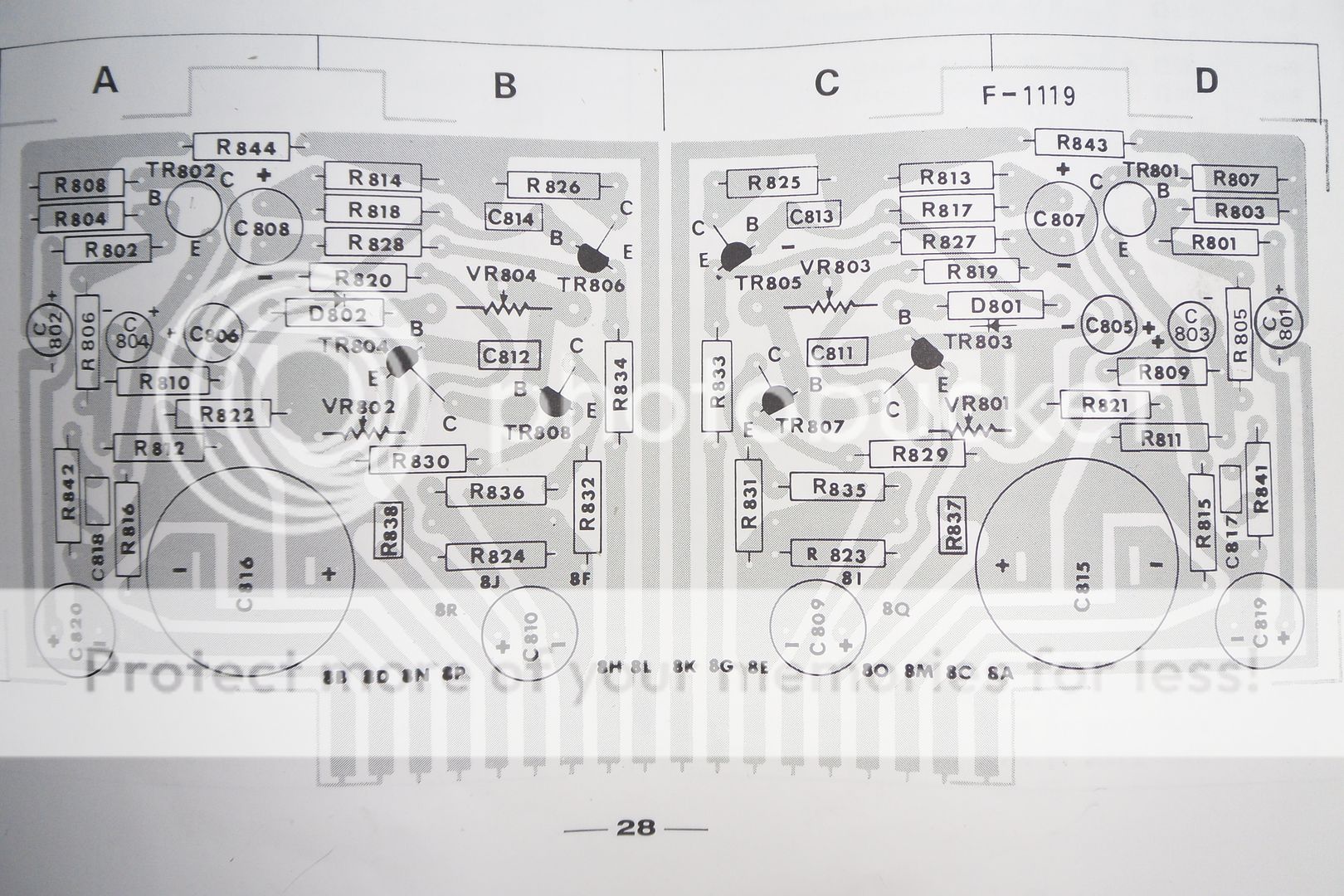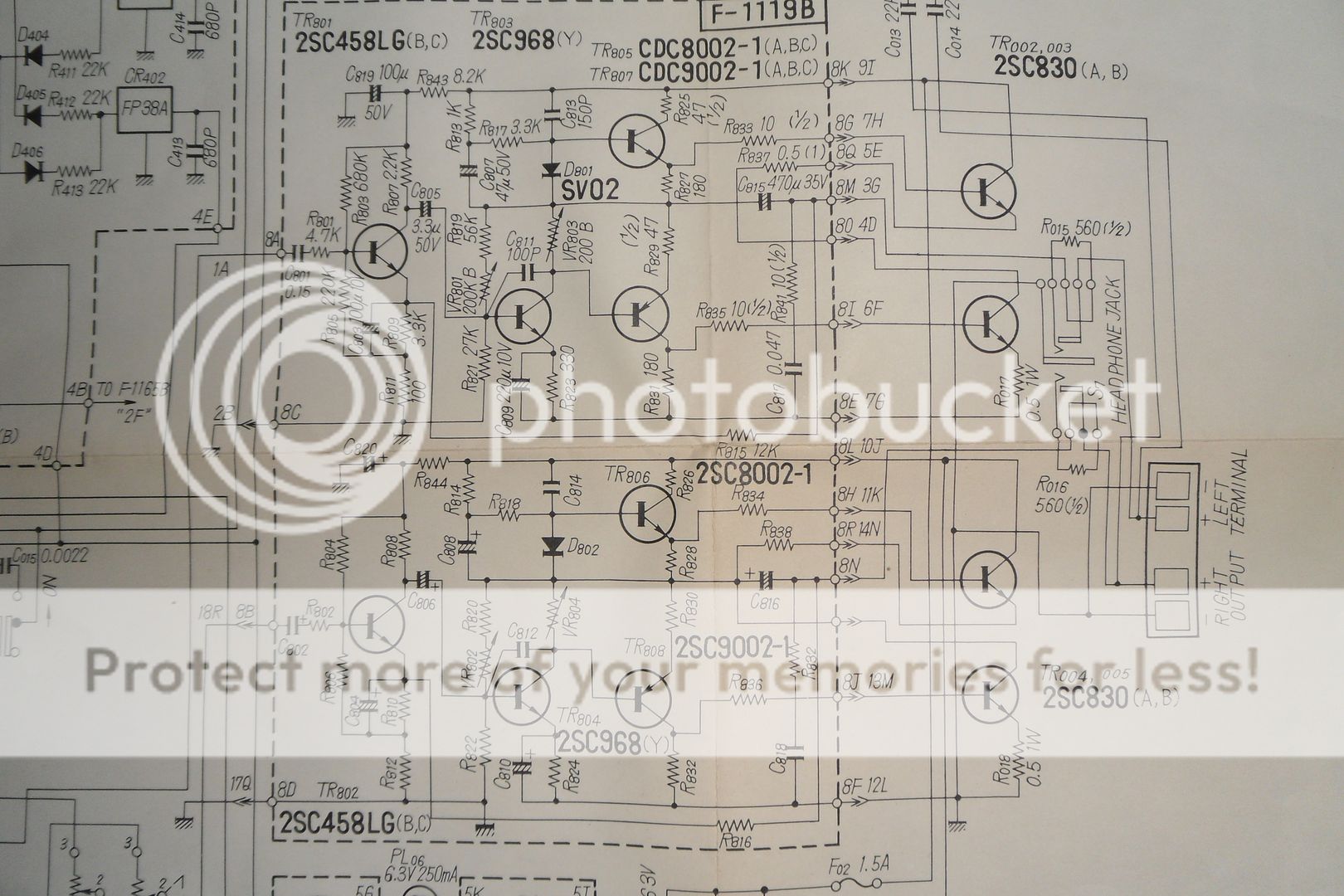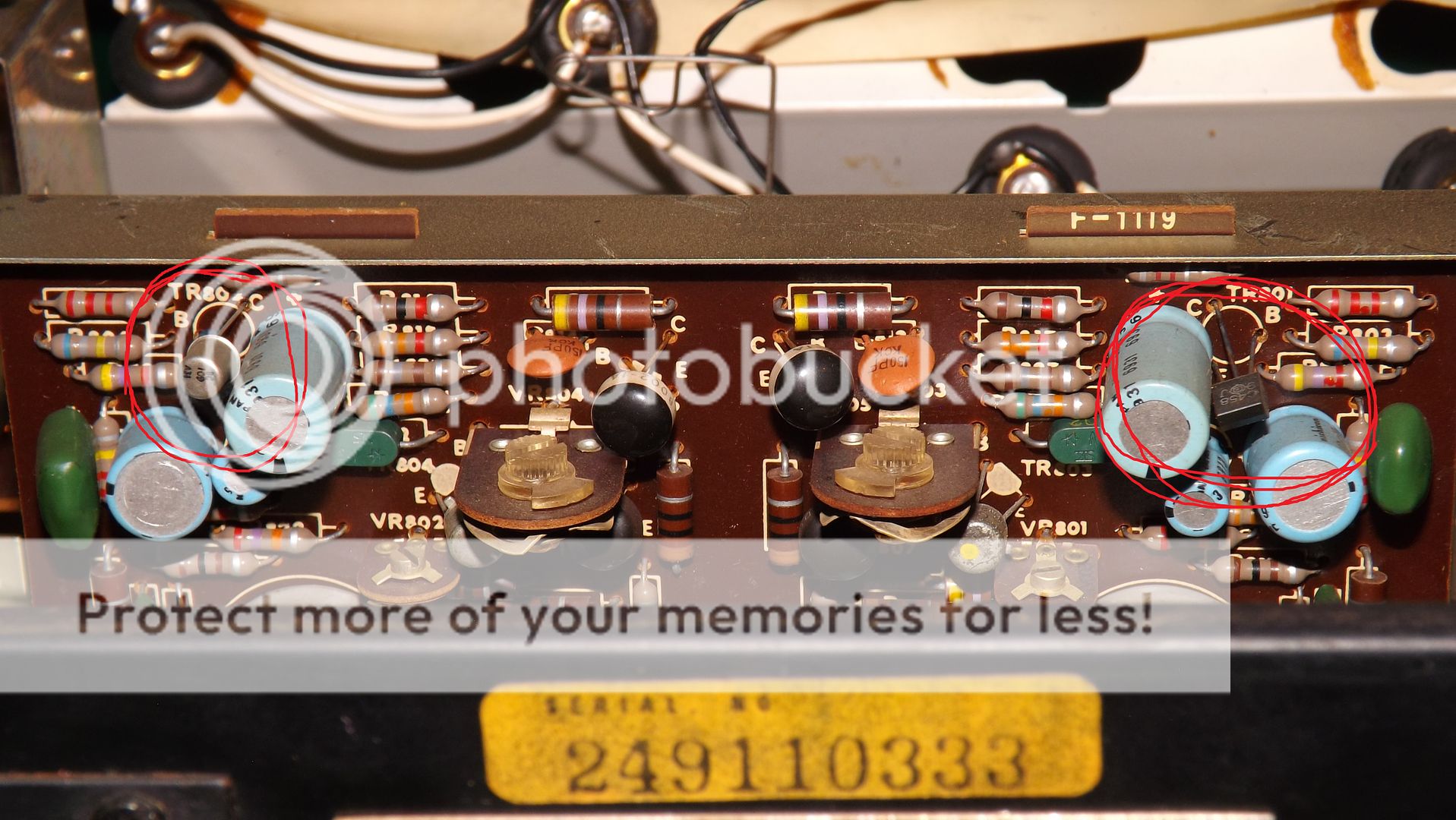Wahab, what are the background noise levels like on your 800?
Noise is huge in respect of currently accepted standards, and it s not due to the ciruitry itself but to the way they designed the preamp section.
The circuits used at the time allowed low distorsion only at levels of 200-300mV, so they did put the volume pot BEFORE the preamp section, and they use a passive tone control that necessitate a 20dB amplification to get the level back to said 200-300mV.
I thought of modding the thing to put the volume pot at the right place but that would mandate re designing the preamp, among other replacing said tone control preamplifier by ICs like the 5532, that s too much hassle and i have quite a collection of other vintage amps that do the job better, and here one can find a better one in scrapping parks anyway....
This is an old Sansui, which means it will hiss, by default. The cause is that all the transistors Sansui used in the 70s go bad. Some especially so, as you've already experienced. Only way to quiet it down is to go full shotgun. Everything must go. A recap is also in order.
Don't count on it. Caps are rarely the problem. Transistors, though - are.
Those amps have a single rail PSU....
I am going to order up a few bits from Farnell, I have been told by a few people to change C815 and C816, whilst I am ordering is there anything else on this driver board that may need changing?
The problem for me is while swapping out parts isn't a problem for me, tracing faults and reading schematics isn't something I have enough experience at to do confidently so any help will be greatly appreciated.
http://i84.photobucket.com/albums/k9/robertgilmore/hi fi/SAM_0087.jpg

http://i84.photobucket.com/albums/k9/robertgilmore/hi fi/SAM_0081.jpg

http://i84.photobucket.com/albums/k9/robertgilmore/hi fi/SAM_0082.jpg

http://i84.photobucket.com/albums/k9/robertgilmore/hi fi/SAM_0088.jpg

http://i84.photobucket.com/albums/k9/robertgilmore/hi fi/DSCF5908b.jpg

The problem for me is while swapping out parts isn't a problem for me, tracing faults and reading schematics isn't something I have enough experience at to do confidently so any help will be greatly appreciated.
http://i84.photobucket.com/albums/k9/robertgilmore/hi fi/SAM_0087.jpg

http://i84.photobucket.com/albums/k9/robertgilmore/hi fi/SAM_0081.jpg

http://i84.photobucket.com/albums/k9/robertgilmore/hi fi/SAM_0082.jpg

http://i84.photobucket.com/albums/k9/robertgilmore/hi fi/SAM_0088.jpg

http://i84.photobucket.com/albums/k9/robertgilmore/hi fi/DSCF5908b.jpg

Please excuse my technical ignorance, but what is a single rail PSU?
An assymmetrical power supply, that is with a single supply voltage, hence there must be a capacitor of decent value in serial with the amplifier output.
In your amp these are C815/816 and their value, 470uF, is too low for 8 ohms speakers, and even for 16 ohms ones.
A correct value is 2200uF at least, and 4700uF if possible, with the existing values the amp doesnt even qualify as HiFi bandwith wise, power (in the speaker) is halved at about 85Hz.
Thank you for the explanation , It does say I can go + 100% however there is this,
''The pic in the second linked thread shows it. I think they are labeled C815/816. That's way too small a cap, but Sansui put the cap inside the feedback loop to let the early amp stages compensate for what would otherwise be some serious LF rolloff.''
Amplifier Distortion, DC-Offset, and You! - Page 276 - AudioKarma.org Home Audio Stereo Discussion Forums
I don't know what LF Rolloff is but its doesn't sound good?
''The pic in the second linked thread shows it. I think they are labeled C815/816. That's way too small a cap, but Sansui put the cap inside the feedback loop to let the early amp stages compensate for what would otherwise be some serious LF rolloff.''
Amplifier Distortion, DC-Offset, and You! - Page 276 - AudioKarma.org Home Audio Stereo Discussion Forums
I don't know what LF Rolloff is but its doesn't sound good?
Thank you for the explanation , It does say I can go + 100% however there is this,
''The pic in the second linked thread shows it. I think they are labeled C815/816. That's way too small a cap, but Sansui put the cap inside the feedback loop to let the early amp stages compensate for what would otherwise be some serious LF rolloff.''
Amplifier Distortion, DC-Offset, and You! - Page 276 - AudioKarma.org Home Audio Stereo Discussion Forums
I don't know what LF Rolloff is but its doesn't sound good?
It will compensate for the capacitor resistance and get a better frequency response but with limited power in the basses, the amp will saturate very early, if there s basses, because the ouput signal before the capacitor is increased to compensate the capacitor losses.
LF roll off is the frequency at wich the losses reach half the power available at mid band, that s -3dB signal attenuation.
In this case the max power is rolled off at relatively high frequency, the lower the frequencies of the basses the lower the max power at wich the amp has uniform reproduction, for instance if it saturate at 20W at 1KHz then 10W output power will saturate the amp at said 85Hz.
So basically the amp wont be as loud as it is now? or is it the opposite effect?
Due to my limited knowledge perhaps I should keep it stock?
Although if upping these caps has a positive effect on sound quality and side effects that wont be audible or negative effects that wont really be noticed unless I crank it up then it cant be a bad thing.
So amp saturation, if I'm understanding this correctly the input will match the output voltage more quickly with bigger caps?
Due to my limited knowledge perhaps I should keep it stock?
Although if upping these caps has a positive effect on sound quality and side effects that wont be audible or negative effects that wont really be noticed unless I crank it up then it cant be a bad thing.
So amp saturation, if I'm understanding this correctly the input will match the output voltage more quickly with bigger caps?
See the output capacitor as a resistance whose value increase proportionaly with decreasing frequency, the lower the frequency the lower the max power.
Currently it is 20W down to about 170Hz and starting from here max power decrease with frequency, at 85Hz it will output 10W at most, at 42Hz it is 5W.
With 2200uf those powers levels are shifted about two octave lower, that is 40, 20 and 10Hz respectively.
So with a bigger cap the amp will sound louder, even in the midrange if there s basses simultaneously.
Currently it is 20W down to about 170Hz and starting from here max power decrease with frequency, at 85Hz it will output 10W at most, at 42Hz it is 5W.
With 2200uf those powers levels are shifted about two octave lower, that is 40, 20 and 10Hz respectively.
So with a bigger cap the amp will sound louder, even in the midrange if there s basses simultaneously.
Currently its rated at 32 watts music power , 14 watts continuous, it actually sounds quite loud, 9 o'clock on the volume and it fills the room, I'm not sure making it louder is a good idea.
Perhaps I should recap it first, get it running right then put bigger caps in it, if it turns out that I can get along with the louder volume I can always change it back.
Is it possible to change the value of something else upstream of the caps to bring the volume down?
Perhaps I should recap it first, get it running right then put bigger caps in it, if it turns out that I can get along with the louder volume I can always change it back.
Is it possible to change the value of something else upstream of the caps to bring the volume down?
Currently its rated at 32 watts music power , 14 watts continuous, it actually sounds quite loud, 9 o'clock on the volume and it fills the room, I'm not sure making it louder is a good idea.
Perhaps I should recap it first, get it running right then put bigger caps in it, if it turns out that I can get along with the louder volume I can always change it back.
Is it possible to change the value of something else upstream of the caps to bring the volume down?
Increasing this capacitor value wont increase the volume, of course...
If your pot is at say 9 and that the amp is not saturated then the volume will be strictly the same, the difference is that the amp wont be saturated as early when you increase the volume, if it saturated at 10 then it will saturate at 11 or 12 for instance..
I have taken another reading with the speakers connected, meter at 200m, reading is 01.7.
I did notice when I switched the amp on there was an initial surge and the volts shot way up before settling down again.
And when its switched off there is still some voltage there for quite some time, enough to make the speakers crackle when removing the speaker cables.
Why go as high as 10 000 µF?
I did notice when I switched the amp on there was an initial surge and the volts shot way up before settling down again.
And when its switched off there is still some voltage there for quite some time, enough to make the speakers crackle when removing the speaker cables.
Why go as high as 10 000 µF?
Increasing this capacitor value wont increase the volume, of course...
If your pot is at say 9 and that the amp is not saturated then the volume will be strictly the same, the difference is that the amp wont be saturated as early when you increase the volume, if it saturated at 10 then it will saturate at 11 or 12 for instance..
I see, so its effecting top end and not how quickly it gets there?
Will I need to adjust anything else of I modify these caps?
To get say 10V signal after the capacitor the amp must output 10V before the capacitor, a 85Hz signal require 20V before the cap to get 10V after the cap.
So if two signals are present the 85Hz one will eat all the available output level before the cap and the amp will saturate at 10V at the speaker, if alone a 1KHZ signal will get up to 20V at the speaker.
So if two signals are present the 85Hz one will eat all the available output level before the cap and the amp will saturate at 10V at the speaker, if alone a 1KHZ signal will get up to 20V at the speaker.
- Status
- This old topic is closed. If you want to reopen this topic, contact a moderator using the "Report Post" button.
- Home
- Amplifiers
- Solid State
- Sansui Solid State 300.